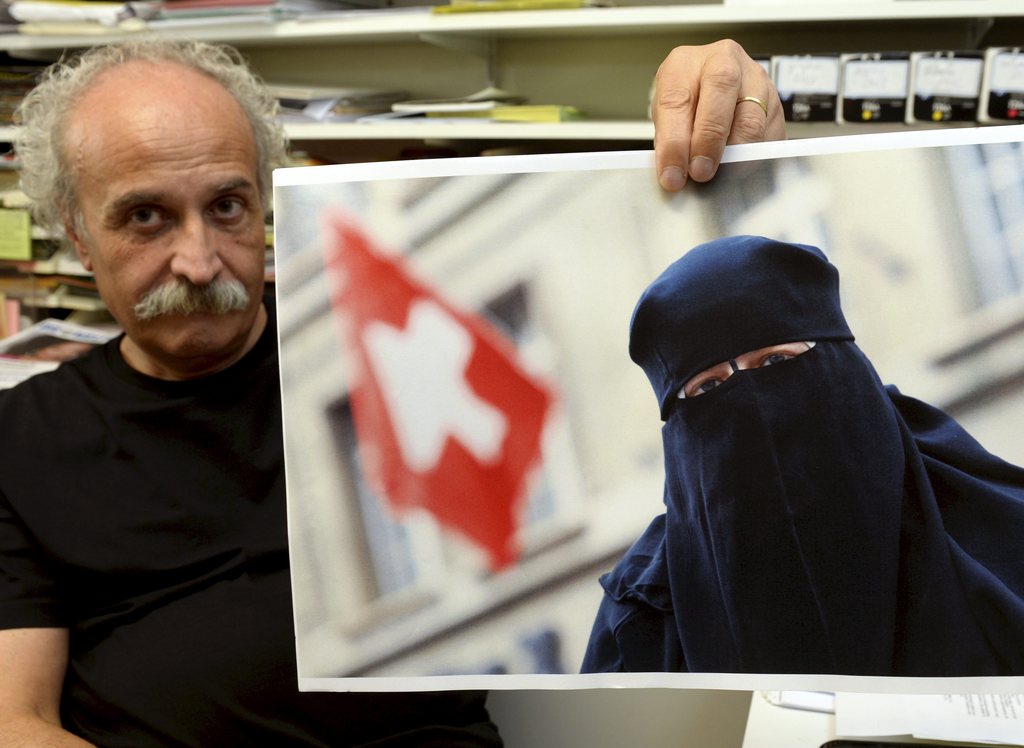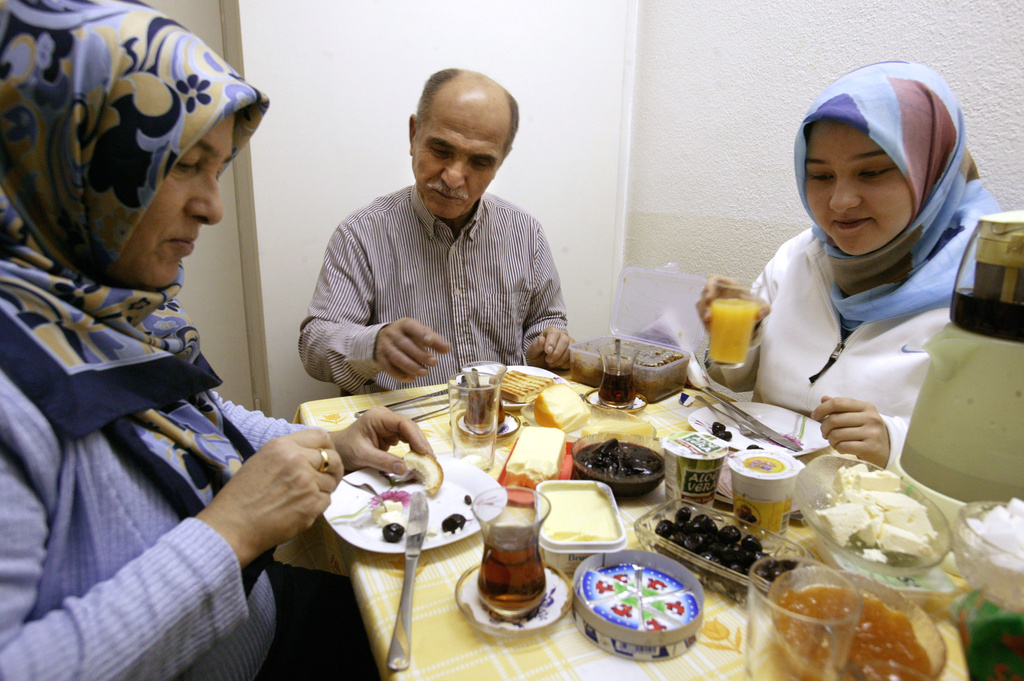When did showing your faith become so controversial?

Whether it’s a turban or a headscarf, showing your religion in Switzerland can make others treat you extremely differently. From stares in the street to difficulty in getting a job, Swiss research has found a religious piece of clothing makes a difference.
Amina Elaian-Talibi was the first in canton Neuchâtel – and one of the first in Switzerland – to wear the hijab, a headscarfExternal link, to school, back when she was 11.
“It was important in the sense that it was the sign of puberty in a girl. It was also a sense of pride because I wanted to show that I was a practising Muslim and that I believed in my religion,” Elaian-Talibi, now 28 and a Swiss citizen, told swissinfo.ch.
She had to fight for her right to wear it at the time, going through a series of appeals, and believes she is still discriminated against today, albeit in a more subtle way.
“Now I am fighting to work as someone who wears a headscarf…I did my studies and now for the past two years I haven’t been able to find work.”
Religious make-up
Elaian-Talibi is one of only 4.9% of people in Switzerland who identify themselves as Muslim, according to the most recent figures from the Federal Statistical Office in 2012.
Members of other religions are so few in number they barely register in the statistics. Could this lack of visibility and a resulting dearth of personal interaction with people wearing religious clothing lead to negative preconceptions?
Jacqueline Grigo, a researcher into religion at the University of Zurich interviewed 20 people in canton Zurich who wore some form of religious clothing and followed six subjects over the course of three years. The aim of her research, published in February 2015External link, was to find out how these people felt they were perceived by society.
“What was interesting from [almost] all of the people was not just the feeling that they were not positively perceived, but the feeling that they were actually discriminated against,” Grigo told swissinfo.ch.
She heard about the difficulties of finding work or being chosen to rent a flat in addition to being insulted, laughed at or even attacked. “They were under the impression that the more people knew about the religion, the easier it would be [for them],” Grigo said.
Elaian-Talibi believes that in general Swiss society is accepting of headscarves, but only “when it remains a private matter”.
“When it goes into the public sphere they’re less [open]. In the workplace they’re not especially open to veiled women.”
Fear of the unknown?
Although it’s estimated only around 100 women in Switzerland wear a burka (a full face and body covering), a people’s initiative banning the covering or concealment of the face in any public place is set to be launched imminently. Signature collection will likely start in the spring.
Based heavily on an initiative on the same topic that voters in canton Ticino approved in 2013, the text does not specifically refer to the burka or niqab (a veil covering the face but not the eyes). A statement released by the rightwing Egerkinger committee behind the idea underlined the right to freedom of expression in Switzerland, commenting that “opinions are expressed in a free country with an uncovered face as free people, and so-to-say face to face”.
The statement added that “parallel structures such as Sharia [Islamic law] have no place in Switzerland” and that Muslims “only call for equality when they are in the minority”.
Elaian-Talibi struggles to understand how the ‘burka ban’, as it has become known, has made its way onto the popular agenda. “This shouldn’t be an issue,” she said, adding that “maybe only a few” women actually wear the burka in Switzerland. “It’s not even worth discussing it.”
Grigo says there is a “certain secularisation ideal” in Europe, meaning people are “essentially not religious or they keep their religion private”.
“That’s why people who wear their religion openly are regarded somewhat suspiciously,” she said.
She also believes that Islam is portrayed “very negatively” in the media in general, often in negative contexts, and that “the Muslims who wear headscarves see the effect of that”. A study of this issue in Switzerland as part of a national research programme found that “political calculations” of rightwing parties and an “over-simplification” by the media were contributing factors to Muslims being portrayed as a threat.
From turbans to habits
Grigo’s research involved a Muslim woman who wears a headscarf, a Catholic nun with a habit, a Tibetan Buddhist monk with a robe, a male orthodox Jew with sidelocks, a hat and a kaftan, a Sikh with a turban and a man from the “Schwarze BrautExternal link” (black beard) group, a non-denominational, youth subculture “who listen to goth-metal music, discuss the Bible and drink beer”.

All lived in canton Zurich, though not all were Swiss, and all had “concrete examples” of prejudice.
“I really experienced the feelings they told me about,” said Grigo as she described the time she spent with each of her study subjects.
“I actually experienced people looking at them with distrust or crossing the street to avoid them or giving them nervous looks…I noticed that.”
But it wasn’t all bad. The Muslim woman in her study recounted times when people asked questions out of genuine interest about her headscarf and the Sikh recalled a time he heard a father explain to his son what the turban stands forExternal link.
“It moved him to tears that someone knew about that and could explain it.”
The common experience for Grigo’s study subjects was turned on its head for the Tibetan Buddhist monk, though.
“Tibet and Buddhism are perhaps somewhat idealised,” Grigo said. His experience so far in Switzerland “was a little uncomfortable because it was like exotifying or idealisation”.
Doing more to explain who these people are beyond the turban or the headscarf is not the real issue for Grigo. Instead, she said, we should be “a bit more sensible about diversity” and “accept that some people are different”.
A preoccupation with headscarves
Human rights organisation Amnesty International criticised Switzerland in its 2015 annual report on a number of points, including current policies and initiatives focusing on head and face coverings.
The report said that a ban in a St Gallen school on headscarves in March 2014 and the vote in favour of banning full face veils in Ticino in 2013 were signs of intolerance.
It reiterated a recommendation of the UN Committee on the Elimination of Racial Discrimination (UN CERD) that Switzerland should set up an independent mechanism to prevent Swiss initiatives conflicting with international human rights laws.

In compliance with the JTI standards
More: SWI swissinfo.ch certified by the Journalism Trust Initiative












You can find an overview of ongoing debates with our journalists here . Please join us!
If you want to start a conversation about a topic raised in this article or want to report factual errors, email us at english@swissinfo.ch.